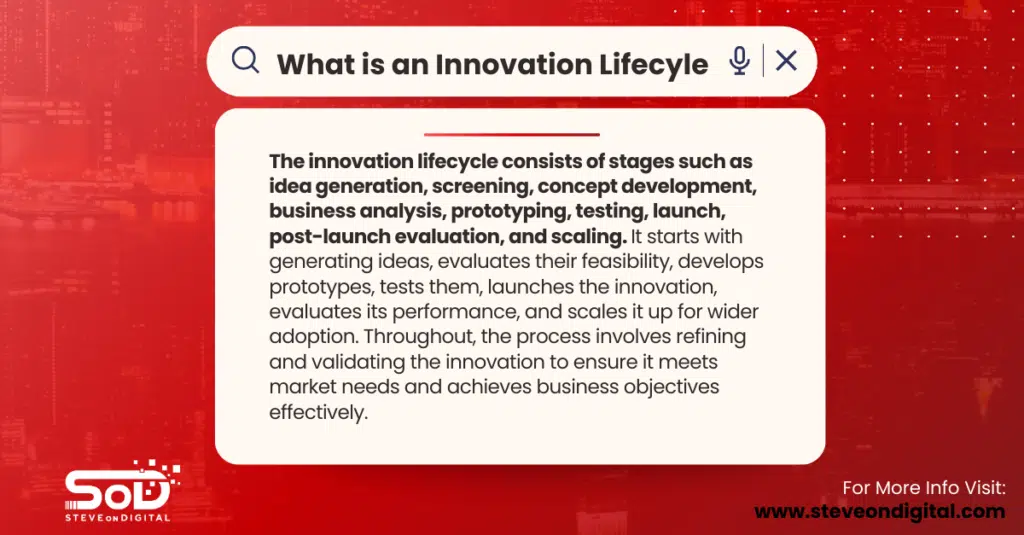What Is Innovation Lifecycle? – SteveOnDigital

Hello, Steve Johnston here, the heart and soul behind SteveOnDigital. With my rich background in electrical engineering, an MBA, and a master’s in Project Management, I’ve dedicated my career to guiding small and medium-sized businesses through the complexities of digital transformation. Today, I’m diving into a topic that’s close to my heart and critical to our future: “What Is Innovation Lifecycle?” In the ever-evolving world of business and technology, understanding the innovation lifecycle is not just beneficial; it’s essential. This concept isn’t merely academic—it’s the backbone of how new ideas flourish, from inception to implementation, shaping our industries and daily lives. This article aims to unravel the layers of the innovation lifecycle, demystifying how it functions and why it’s a linchpin in achieving successful innovation. We’ll start with a basic understanding, move through a detailed comparison with similar concepts, and finally discuss its significance. By the end of this journey, you’ll not only grasp what the innovation lifecycle is but also why it’s indispensable in today’s fast-paced world. Part 1: Understanding The Innovation Lifecycle Definition And Explanation Of The Innovation Lifecycle At its core, the innovation lifecycle is a framework that outlines the journey of an idea from its genesis to its realization and beyond. It encapsulates several stages—idea generation, market analysis, development, and implementation—each crucial in transforming a spark of creativity into tangible, impactful innovation. This lifecycle isn’t linear; it’s a cyclical process that fosters continuous improvement and adaptation, ensuring ideas are not just created but are viable, relevant, and successful. Drawing from my experiences, I’ve seen firsthand how aligning with the innovation lifecycle can pivot a business from stagnation to growth. It’s not just about having a groundbreaking idea; it’s about meticulously nurturing that idea through each phase of the lifecycle, ensuring it’s robust, well-researched, and market-ready. Stage Objective Key Activities Idea Generation Foster creativity and gather viable ideas Brainstorming, cross-functional workshops, idea incubation programs Market Analysis Understand market needs and validate the idea Market research, SWOT analysis, customer interviews Development and Testing Turn ideas into tangible solutions and validate with users Prototyping, agile development, user testing Implementation and Market Introduction Launch the product and gain market traction Marketing strategy, product launch, market feedback analysis Comparison With The Innovation Process, Innovation Life Cycle, And Innovation Cycle While these terms might seem interchangeable at first glance, they offer nuanced perspectives on innovation: Each perspective offers valuable insights, but understanding innovation as a lifecycle underscores the importance of revisiting and refining ideas, adapting to market feedback, and evolving with technological advancements. It’s a holistic view that encompasses not just the creation of innovations but their sustained development and maturation over time. The Significance Of Viewing Innovation As A Lifecycle for Successful Innovation Viewing innovation through the lens of a lifecycle is transformative. It shifts the focus from one-time successes to ongoing growth, encouraging businesses to cultivate a culture of continuous innovation. This perspective is vital for several reasons: The Stages Of The Innovation Lifecycle The innovation lifecycle is not a mere sequence of steps; it’s a dynamic journey that an idea traverses to become a reality. This journey is marked by four key stages, each serving a distinct purpose and requiring specific strategies for success. 1. Idea Generation The genesis of innovation lies in idea generation. This stage is all about fostering creativity and encouraging the free flow of ideas within the team. It’s crucial to create an environment where team members feel empowered to share their thoughts, no matter how outlandish they may seem. Techniques such as brainstorming sessions, idea incubators, and encouraging cross-functional collaborations have been instrumental in my experiences with generating viable ideas. Enhance Idea Generation: 2. Market Analysis Following the burst of creativity, market analysis grounds the process by aligning ideas with customer needs and market demand. This stage involves rigorous research to identify not only the potential market size but also the early adopters and the early majority who will be pivotal in the initial uptake of the innovation. Understanding the competitive landscape is equally important, as it shapes the strategy for differentiation and positioning. Key Aspects Of Market Analysis: 3. Development And Testing Transitioning from an abstract idea to an actual solution, the development and testing phase is where concepts are brought to life. This stage is characterized by designing, prototyping, and refining the product or service. It’s a phase marked by both excitement and challenges, as the team works to translate ideas into functional, market-ready solutions. Access to adequate resources, both human and technical, is crucial here. My approach has always been to embrace iterative development, encouraging feedback from potential users and stakeholders to refine the product continuously. Strategies For Effective Development And Testing: 4. Implementation And Market Introduction The final hurdle before an innovation meets its audience is implementation and market introduction. This stage is about more than just launching a product; it’s about strategically introducing it to the market to ensure maximum impact. Timing, marketing strategy, and understanding the adoption phases (early majority, late majority) play critical roles in this phase. Speed to market is essential but so is ensuring that the product meets the customer needs identified in the market analysis stage. Leveraging digital marketing, engaging with influencers who resonate with early adopters, and continuous monitoring of market response are part of my arsenal for successful market introduction. Tips For Successful Implementation And Market Introduction: Navigating through these stages requires not just a robust understanding of the process but also the agility to adapt as each stage presents its own set of challenges and opportunities. My experiences have taught me that each phase of the innovation lifecycle is interconnected; success in one stage builds the foundation for success in the next. Part 3: Critical Factors For Successful Innovation Innovation is not a serendipitous event; it’s a complex process that requires strategic foresight and meticulous planning. Through my experiences, I’ve identified several key factors that are instrumental in navigating the innovation lifecycle successfully: Team Expertise The foundation of any successful

